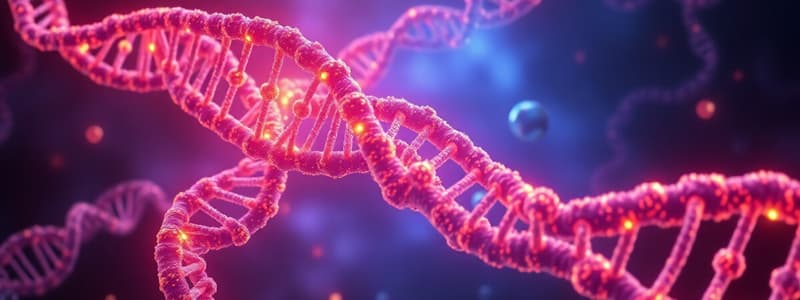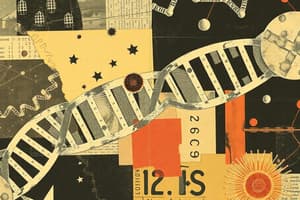Podcast
Questions and Answers
What best describes the structure of DNA?
What best describes the structure of DNA?
- A single strand consisting of ribose sugars and uracil bases.
- A linear chain of amino acids connected by peptide bonds.
- A double helix consisting of two strands with adenine, thymine, cytosine, and guanine. (correct)
- A circular molecule made entirely of nucleotides.
Which of the following accurately describes the roles of RNA in protein formation?
Which of the following accurately describes the roles of RNA in protein formation?
- RNA is solely responsible for the synthesis of ribosomal components.
- RNA carries genetic information exclusively between cells.
- RNA transcribes information from DNA and translates it into proteins. (correct)
- RNA aids in DNA replication within the nucleus.
In what way do prokaryotic cells differ from eukaryotic cells?
In what way do prokaryotic cells differ from eukaryotic cells?
- Prokaryotic cells do not contain organelles. (correct)
- Eukaryotic cells are typically smaller than prokaryotic cells.
- Eukaryotic cells lack a cell membrane.
- Prokaryotic cells have multiple nuclei.
What initiates the production of tryptophan in E. coli when tryptophan is removed?
What initiates the production of tryptophan in E. coli when tryptophan is removed?
Which statement accurately differentiates between transcription and translation?
Which statement accurately differentiates between transcription and translation?
What experimental evidence did Watson and Crick rely on to propose the structure of DNA?
What experimental evidence did Watson and Crick rely on to propose the structure of DNA?
What is a significant difference between DNA and RNA in terms of structure?
What is a significant difference between DNA and RNA in terms of structure?
What occurs during the translation phase of protein synthesis?
What occurs during the translation phase of protein synthesis?
What occurs when tryptophan is added to E. coli?
What occurs when tryptophan is added to E. coli?
Which characteristic is unique to eukaryotic cells compared to prokaryotic cells?
Which characteristic is unique to eukaryotic cells compared to prokaryotic cells?
How does RNA differ from DNA in terms of nucleotide composition?
How does RNA differ from DNA in terms of nucleotide composition?
During which phase of protein synthesis does the mRNA serve as a template to create proteins?
During which phase of protein synthesis does the mRNA serve as a template to create proteins?
What is the function of RNA polymerase during transcription?
What is the function of RNA polymerase during transcription?
What is the relationship between codons and tRNA during translation?
What is the relationship between codons and tRNA during translation?
How did Watson and Crick conclude the double helix structure of DNA?
How did Watson and Crick conclude the double helix structure of DNA?
What is a primary feature of protein formation in cells?
What is a primary feature of protein formation in cells?
Flashcards
DNA structure
DNA structure
DNA is a double helix with two strands. Each strand has sugar, phosphate, and bases (A, T, C, G). A pairs with T, and C pairs with G.
DNA discovery
DNA discovery
Watson and Crick used Rosalind Franklin's X-ray images to discover the DNA double helix shape in 1953.
DNA vs. RNA
DNA vs. RNA
Both have nucleotides (sugar, phosphate, bases), carry genetic info. DNA is double-stranded, RNA is single-stranded. DNA has thymine, RNA has uracil.
Eukaryotic vs. Prokaryotic cells
Eukaryotic vs. Prokaryotic cells
Signup and view all the flashcards
Transcription
Transcription
Signup and view all the flashcards
Translation
Translation
Signup and view all the flashcards
Tryptophan regulation
Tryptophan regulation
Signup and view all the flashcards
Protein Formation
Protein Formation
Signup and view all the flashcards
What makes up a DNA strand?
What makes up a DNA strand?
Signup and view all the flashcards
How do DNA bases pair?
How do DNA bases pair?
Signup and view all the flashcards
Who discovered DNA's structure?
Who discovered DNA's structure?
Signup and view all the flashcards
What's the key difference between DNA and RNA?
What's the key difference between DNA and RNA?
Signup and view all the flashcards
What is an operon?
What is an operon?
Signup and view all the flashcards
What does tryptophan do to the trp operon?
What does tryptophan do to the trp operon?
Signup and view all the flashcards
What happens when tryptophan is removed?
What happens when tryptophan is removed?
Signup and view all the flashcards
What are the two main steps of protein synthesis?
What are the two main steps of protein synthesis?
Signup and view all the flashcards
Study Notes
DNA Structure
- DNA is a double helix with two strands.
- Each strand is composed of sugar, phosphate, and four bases (A, T, C, G).
- A pairs with T, and C pairs with G.
DNA Discovery
- Watson and Crick determined DNA's double helix structure in 1953.
- Their work relied on X-ray diffraction data from Rosalind Franklin.
DNA vs. RNA
- Similarities: Both contain nucleotides with sugar, phosphate, and bases; both carry genetic information.
- Differences: DNA has thymine (T), RNA has uracil (U). DNA is double-stranded, RNA is single-stranded.
Eukaryotic vs. Prokaryotic Cells
- Eukaryotic: Contains a nucleus and organelles (like plant and animal cells).
- Prokaryotic: Lacks a nucleus and is smaller (e.g., bacteria).
Transcription vs. Translation
- Transcription: DNA creates RNA in the nucleus.
- Translation: RNA creates proteins in the ribosome.
Protein Synthesis Process
- Transcription:
- Occurs in the nucleus.
- DNA serves as a template to generate messenger RNA (mRNA).
- RNA polymerase builds a complementary mRNA strand using DNA's instructions (e.g., DNA's A pairs with RNA's U).
- Translation:
- Occurs in the ribosome (cytoplasm).
- mRNA is read in three-base codons.
- Each codon corresponds to a specific transfer RNA (tRNA) carrying a particular amino acid.
- tRNA delivers the correct amino acids to the ribosome, forming a protein chain.
- The chain continues until a stop codon is encountered.
- The final protein folds into its functional shape.
Tryptophan Regulation in E. coli
- Tryptophan Addition: Tryptophan binds to a repressor protein, activating it.
- The activated repressor blocks RNA polymerase from transcribing genes for tryptophan production, conserving energy.
- Tryptophan Removal: Without tryptophan, the repressor becomes inactive, allowing RNA polymerase to transcribe genes to synthesize tryptophan.
- This process demonstrates how E. coli regulates tryptophan biosynthesis based on environmental levels.
Studying That Suits You
Use AI to generate personalized quizzes and flashcards to suit your learning preferences.




